How to exercise if you really don’t like exercise

When you think about exercise, what comes to mind? Lots of us think exercise means intense sweat sessions or long-distance runs, which can be off-putting. Others are really worried about how they might look when exercising, which takes away the enjoyment factor entirely. The good news is that healthy exercise just means moving your body more – and it doesn’t have to involve activewear, gyms or large chunks of time at all!
“I think a lot of men and women feel that to be fit or to be healthy they have to be exercising in a certain way, and a lot of that is driven by what we see on Instagram – booty workouts, or these big weightlifting sessions,” says psychiatrist Dr Kieran Kennedy.
If you don’t enjoy those things – or you just hate getting sweaty – exercise might not seem appealing. But there are lots of ways exercise can be enjoyable (or at least, engaging enough that you’ll keep going). Here, Dr Kennedy shares his best tips.
Choose activities you like
The best form of exercise is one you enjoy – which means you’ll keep it up, Dr Kennedy says. Try these great ideas:
- Bike around your neighbourhood. As you get fitter, challenge yourself by adding hills and extending your track.
- Form a walking group with a friend, so you can keep each other motivated. This will help you feel more connected to others, which is another win for your mental health.
Make it a priority
It isn’t possible to get more hours in the day (unfortunately!) but we can change the way we organise our time. To make exercise happen, you need to make it a priority in your schedule, Dr Kennedy says.
“I often find with patients that once we actually sit down and talk through how they’re spending their day, we can often find more moments where exercise might be injected than they’d actually thought,” Dr Kennedy says. For example: “It might be swapping 30 minutes of Netflix for a 30-minute walk in the evening.”
Aim for 30 minutes of moderate-intensity exercise, most days of the week (which means you’re working hard, but not too hard). Tip: You can break this up into three 10-minute sessions a day – you’ll still get the benefits!
Multitask your activities
Heard of incidental exercise? That’s when we turn our existing activities into opportunities for physical activity – think: cycling to the shops instead of driving, or doing lunges and squats while you’re watching TV.
“I think for people who are very busy, and working really hard, just fitting it in around the rest of your day can be really powerful for your health,” he says. “So it might be going for a walk on your lunch break, or it might be walking to the train station instead of getting dropped off by your partner.”
Just start somewhere
Whatever exercise you choose to do, the most important thing is to just get started. Action feeds motivation, Dr Kennedy says.
“Once we start, we find that our motivation and our momentum with exercise really gets going,” he explains. “It’s about starting small, then that becomes a snowball, and we start to feel more empowered and more comfortable with it.”